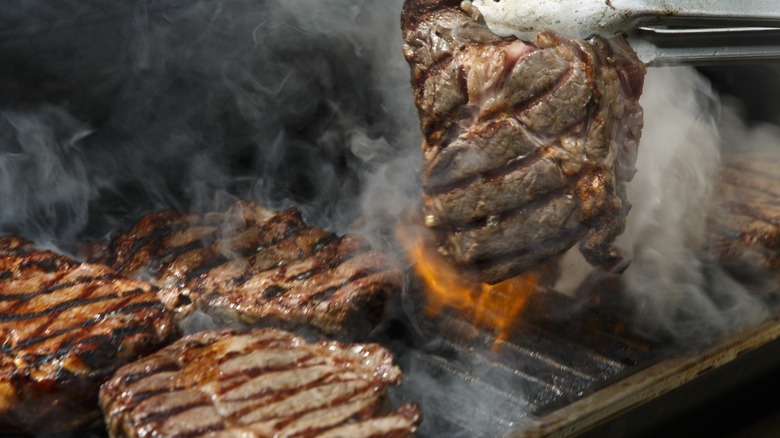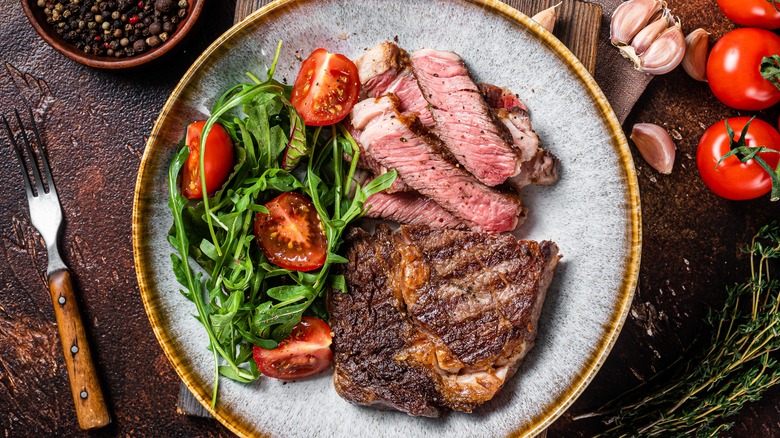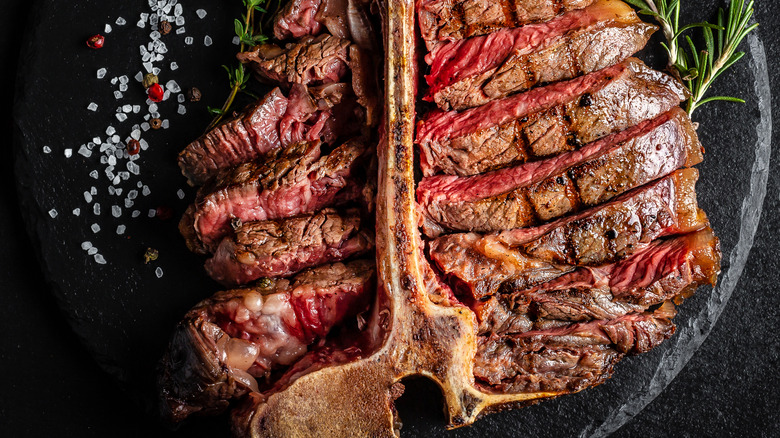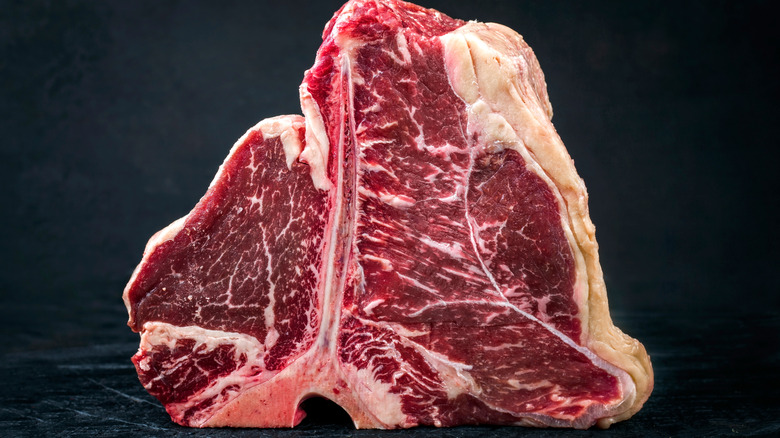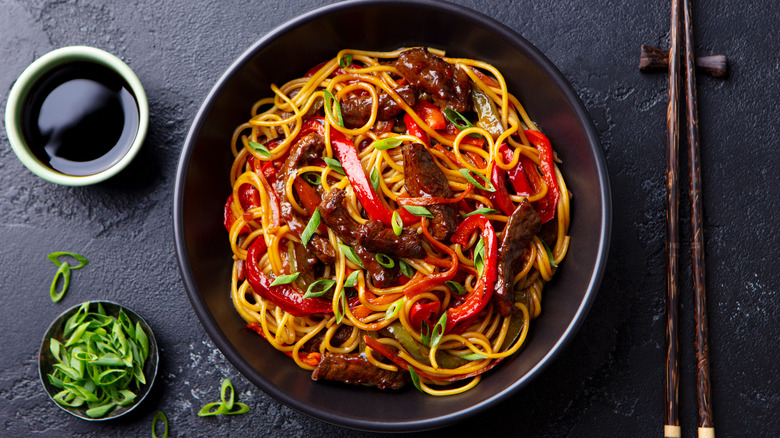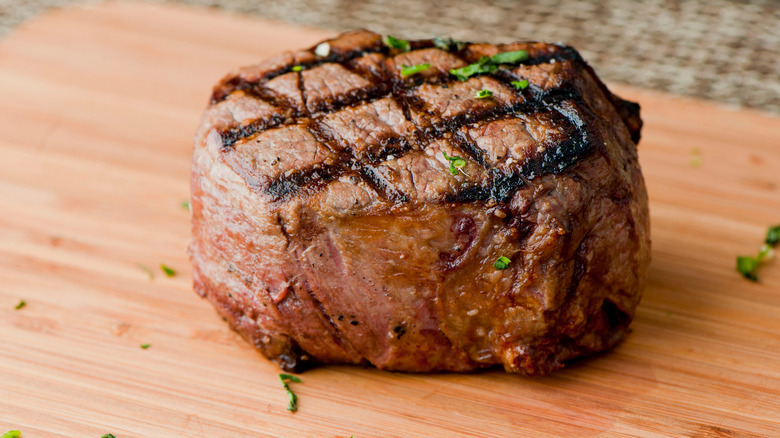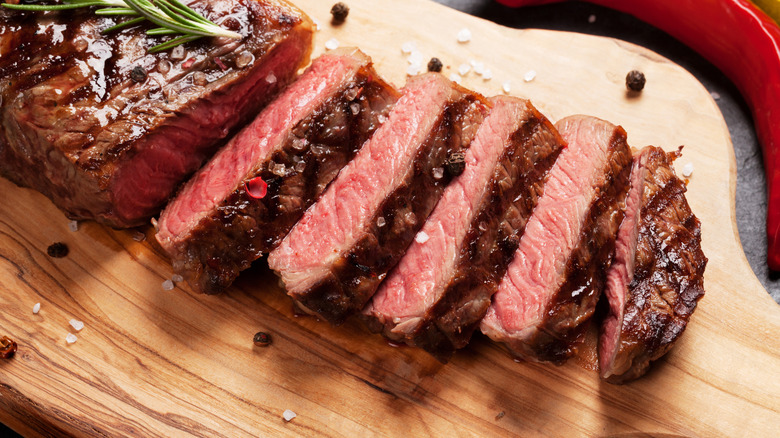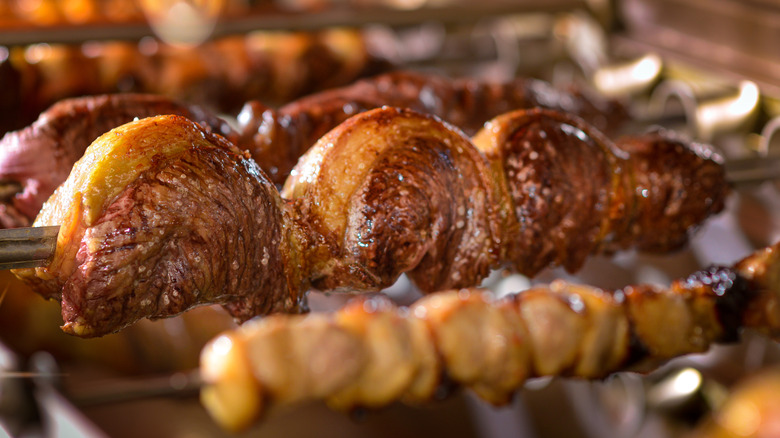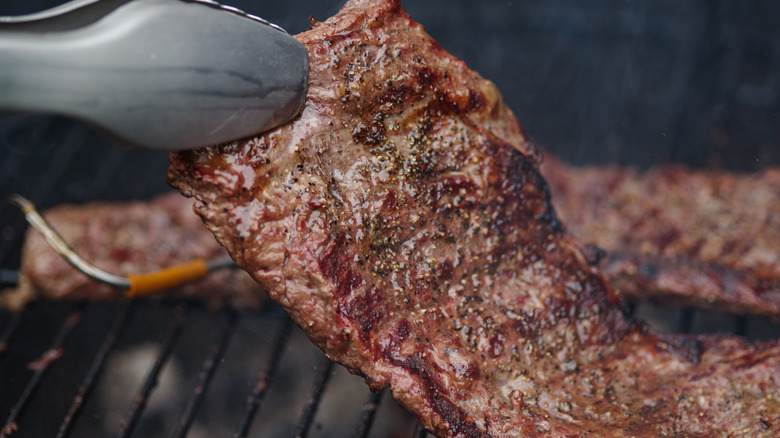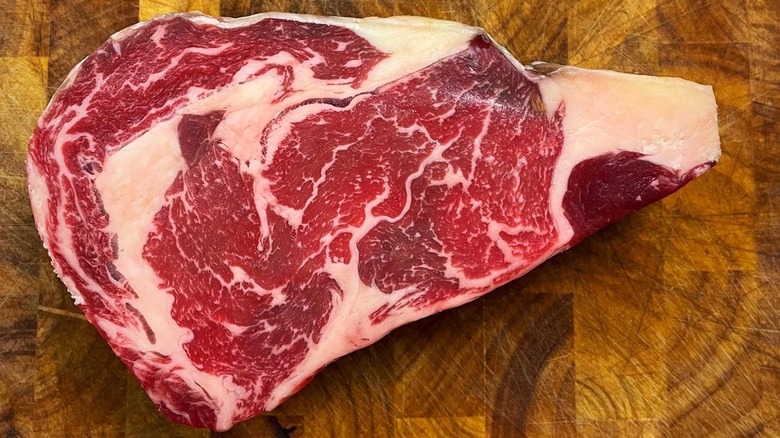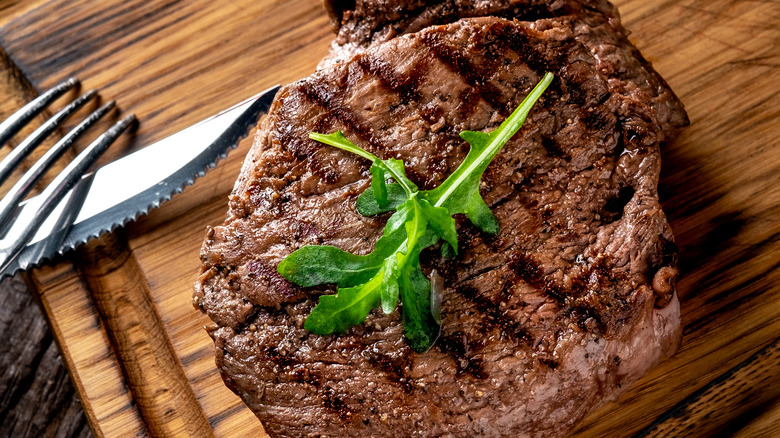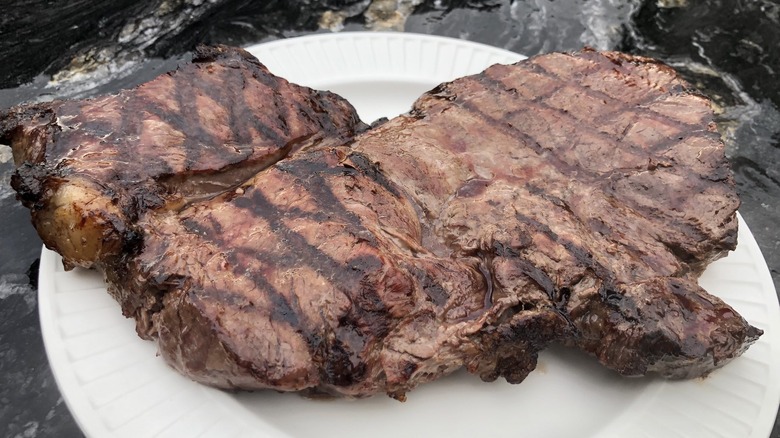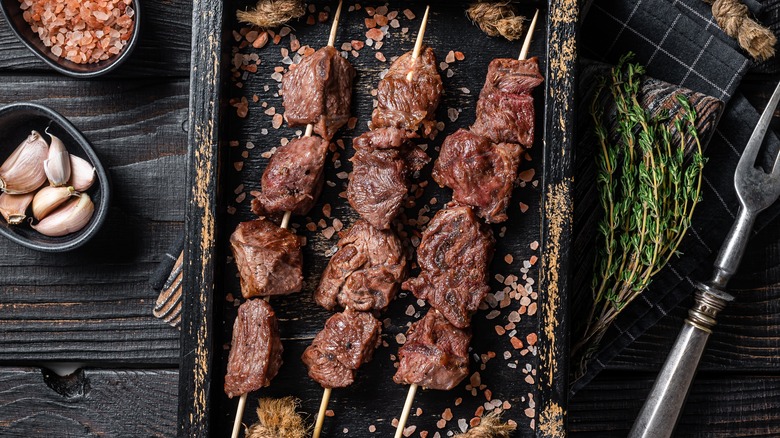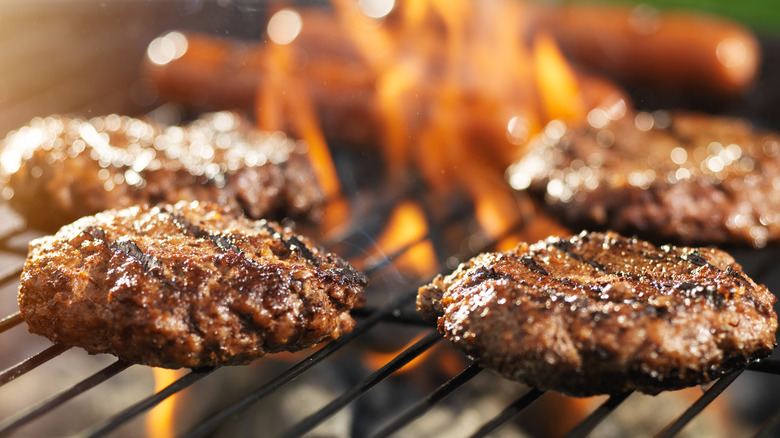The 13 Best Steaks For Grilling
When you think of food cooked on a grill, it's probable that one of the first things you conjure up in your mind is a thick, juicy steak, along with the usual hamburgers and hot dogs. Steak just tastes great when cooked on a grill. The Maillard Reaction takes place, which brings out its deep, meaty flavors, turning it an amazing color on the outside and keeping it tender and juicy on the inside.
However, if you've shopped for steak at the supermarket or visited your local butcher, you know there are numerous steak cuts to choose from. Plus, some cuts have several different names, which can cause even more confusion when you're trying to find one to buy. That's precisely why we've created this ultimate guide to the best steaks for grilling. If you know what you're doing with the grill, you can turn almost any steak into a masterpiece. But this guide tells you everything you need to know about the best steaks to grill for different situations, whether you're prioritizing flavor and texture, or want the most affordable steak for your budget. Plus, how to grill your chosen steak perfectly every time.
1. Ribeye is an all-round winner
The ribeye steak is one of the most popular cuts to find at a steakhouse. It's grilled in just a few minutes for exceptional flavor and texture. This cut comes from the rib area of the cow — specifically ribs six through 12 — and a butcher can leave the bone intact or cut around it (per Omaha Steaks). You'll likely recognize it for the "eye" of fat.
Ribeye is an excellent choice for the grill. The top reason it does so well is because of the marbling — another word for fat content — that runs throughout the meat. These are the thin white-ish lines you'll see on the steak. This fat cooks down as the meat cooks, dispersing to add flavor and keep it juicy and tender. According to Utah State University meat scientist Sulaiman Matarneh (via Smithsonian Magazine), "If you have more marbling, the meat will be tenderer, juicier, and it will have richer flavor." So, if you've ever been traumatized by trying to eat a dry, chewy grilled steak, grill a ribeye. It's unlikely to disappoint.
2. Want two steaks? Grill a T-bone
T-bone steak gets its name from the T-shaped bone that runs through its center. What's not as obvious to many people is that the cut actually contains two different types of steak: a tenderloin and a strip steak (per Certified Angus Beef). If you can't make up your mind about what kind of steak to grill, T-bone gives you two different flavors and textures in one convenient cut.
There is something to be mindful of, though, if you want to grill a T-bone steak: The strip and tenderloin steaks cook differently. It's common for the tenderloin portion to be thicker than the strip portion, which can lead to part of your steak becoming undercooked or overcooked on the grill. Flipping the T-bone steak once during the grilling process can help both sides cook evenly. Chicago Steak Company also suggests preparing your grill with low-heat and high-heat areas — one at 450-500 degrees Fahrenheit and the other at 250-275 degrees Fahrenheit — allowing you some more control over how well done your T-bone ends up. It should take around 15-20 minutes (plus resting time) to cook a T-bone steak to medium-rare on the grill, but it'll be worth it.
3. Go bigger with a porterhouse
A porterhouse steak is a wonderful thing: You get the winning combination of a butter-soft filet mignon, plus the intense meatiness of a strip steak, in one package. It's very similar to a T-bone in that it has the same bone running through its middle and separating a tenderloin from a strip steak. So, you'll get the same delicious flavors, except the porterhouse is a bit larger. Rube's Steaks explains that the porterhouse has a notably larger tenderloin portion, making the cut bigger and heavier than the T-bone.
Although the size of this cut makes it a bit costlier at the checkout, you'll also get plenty of meat for two people. Grilling the porterhouse won't be much different if you've already experimented with grilling a T-bone. However, you should pay close attention to the thicker, chunkier tenderloin side, which may need a few more minutes over direct heat to cook to the proper internal temperature — which should be 130-135 degrees Fahrenheit for medium-rare — compared to the T-bone's tenderloin side.
4. Grill up some flat iron steak for stir-fry
If you haven't heard of flat iron steak — also known as top blade steak — you aren't alone. According to Omaha Steaks, it's one of the newer cuts to hit shelves after researchers found you could use the portion, which was usually turned into hamburger meat, as a delicious steak. Now, using the right techniques, butchers can remove the flat iron, which comes from the highly-exercised chuck shoulder area, to reveal a relatively thin, tender piece of beef.
You can certainly eat a flat iron steak on its own after grilling it, but because it can be a little on the chewier side, flat iron has become a popular option for any dishes using sliced steak. Stir-fry tops the list, but steak salad, sandwiches, and fajitas are great additional options.
Flat iron doesn't usually take more than 10 minutes to cook on the grill and it sees its best results when cooked to medium-rare. Rest the steak for five to 10 minutes after grilling before slicing it against the grain to add to beef stir-fry. You might also want to marinate the steak before grilling with ingredients like ginger and soy sauce, that pair well with your stir-fry.
5. Grilled filet mignon is an absolute must
Filet mignon is a steak cut you typically see at upscale restaurants rather than more traditional steakhouses. That's because this cut is considered a delicacy of the steak world. It doesn't tend to have as much beefy flavor as other steaks that you'd normally consider grilling, like ribeye and strip steak, but its incredibly tender, butter-soft texture makes up for its more modest flavor.
The grill tends to bring out a lot of flavor in meat, which is why it's a good option for filet mignon. However, this cut is much thicker than others, making it challenging to grill to the right temperature without overcooking the outside. The Chicago Steak Company recommends a cook time of about five minutes on each side, at 450 degrees Fahrenheit, removing the steak when it reaches about 125 degrees Fahrenheit internally for medium-rare. If your filet needs some extra time to reach the right temperature in the middle, move it to an indirect heat area of the grill for a few more minutes.
6. The New York strip packs a lot of flavor
Onto the well-known New York strip steak, also known simply as a strip steak. Yes, this steak makes up one-half of a T-bone or porterhouse. Strip steak comes from the same area of a cow as the ribeye, but from the lower, more exercised portion. Therefore, it has less fat and can be on the chewier side, but it's also loaded with meaty flavor that many steak lovers appreciate, making it one of the most popular options on a steakhouse menu (via MasterClass).
Something important to remember when grilling strip steak is that because it doesn't have a lot of fat content, you won't need to worry about flare-ups as much as you might with a fattier piece of steak, like ribeye. On the other hand, you do have to be careful not to let the steak dry out. To prevent that, be sure to only cook the steak over high direct heat for a few minutes to sear the outside, and finish cooking with indirect heat. Also, brushing the steak with a little neutral oil before grilling can help it stay moist. You can also top it with a dab of compound butter as it rests after cooking to introduce a little more fat and moisture into the meat.
7. Brazil loves grilled picanha steak
Picanha may not be something you've heard of yet, but it's definitely not one to pass up if you're a superfan of grilled steak. You might also hear this cut referred to as a top sirloin cap roast or coulotte roast. According to What About Brazil?, picanha steak has a rich history in Brazil and is one of the country's most prized cuts of meat. Picanha comes from the rump area, which is known for being quite fatty. However, the fat that comes with picanha is actually what makes it so special. Traditionally, the fatty area, known as a fat cap, remains on picanha while cooking it, allowing it to cook down into the meat for an incredible amount of flavor in each bite.
Picanha is traditionally cooked on skewers in a rotisserie, but you can mimic this method using your grill. First, slice picanha into separate steaks, each containing a portion of the fat cap. Season each steak. Then, fold the steaks in half and thread onto skewers. Grill as usual, searing each steak over high heat before cooking them on low heat until they reach medium-rare.
8. Hanger steak offers a quick cook on the grill
Don't have a lot of time to spare? Grill hanger steak. This steak is also known as the hanging tender or butcher's steak. It comes from the section underneath a cow's ribs, serving the purpose of keeping the diaphragm attached to the ribs. When butchered, the hanger steak has a thick line of connective tissue running down the center, which some butchers remove to form two pieces of meat (per the University of Minnesota Extension).
Because this cut is so thin and doesn't have much fat, it offers a super-quick cook on the grill. Therefore, hanger steak is best to use when you are standing by your grill, as it won't take any more than a couple of minutes on each side to finish cooking. For the best results, place the hanger steak on a grill plate and baste it with butter or Worcestershire sauce while grilling to help it stay tender and juicy. The meat should reach 125 degrees Fahrenheit internally for medium-rare or 135 degrees Fahrenheit for medium.
9. Delmonico tastes like a pricier cut
Do you want a steak to cook on the grill that tastes similar to ribeye but isn't as costly? Try Delmonico. Delmonico steak is named after a pair of siblings from Switzerland who originally brought awareness to the cut in America and eventually opened up their own restaurant known as Delmonico's (per Alpine Butcher). Although its introduction was about two centuries ago, many still don't know about this flavorful piece of steak, which is actually so similar to a ribeye that some people think it is one.
However, Snake River Farms explains that Delmonico does come from the rib area of a cow, but it's specifically cut from the end of that area, allowing for only two Delmonico steaks from each animal. The Delmonico steak has a good amount of fat content like ribeye, keeping it tender when grilled. And, you can grill it just like you would a ribeye. Despite it almost mimicking the taste and texture of ribeye, Delmonico is usually cheaper per pound, perhaps only because it's not as well-known as the prestigious ribeye.
10. Chuck steak is ideal for marinating
You might not reach for chuck steak first at the butcher counter unless you're basing your choice solely on affordability. Chuck steak certainly costs less per pound than, say, a ribeye or New York strip steak. But it's also known for being relatively chewy because it comes from the highly muscular shoulder area.
Tough meat and grilling don't usually go hand in hand. However, chuck steak is one that works well with a tasty steak marinade before grilling. Not only will it absorb the marinade's flavors, but an overnight marinade can also tenderize the meat to prepare it for the grill. The University of Nebraska-Lincoln recommends marinating chuck steak for at least six hours to allow the marinade enough time to break down stubborn collagen fibers. For best results, a marinade that will up your steak game needs fat, acid, enzymes, salt, sweetening agents, and your favorite herbs and spices to really do its job (via Jessica Gavin).
11. Top sirloin is tasty and affordable
Sirloin steak is one of the most popular cuts in the world. The sirloin portion of a cow sits behind the ribs and loin and directly in front of the rump area. You might also know it as a center-cut steak or butt steak. Top sirloin is considered a lean cut of steak with less than two grams of saturated fat per serving (per Beef, It's What's for Dinner). However, there's still enough fat content combined with moderately tender meat to keep top sirloin juicy when grilling.
According to Cattlemen's Steakhouse, the most important thing to remember when cooking top sirloin on the grill is to avoid overcooking it. This cut does best when it's grilled to medium-rare, maximum, but rare might be even better. Cooked past medium-rare, you might end up with a chewy steak. Over a very high heat, cook the steak for a couple of minutes on each side. To keep top sirloin juicy as it rests off the grill, drizzle it with a small amount of olive oil or melted butter.
12. Grilled flank steak makes tasty kebabs
Flank steak is one of the leaner cuts of beef, so it will need a little more care when thinking about how to use it. However, when grilled correctly, flank steak also packs a significant punch of meaty flavor. That's one of the reasons it makes a delicious steak kebab. Added to the other numerous flavors of vegetables, herbs, and marinades, flank steak adds just the right amount of beefy balance to a kebab. Flank steak also needs to cook quickly to avoid drying out and becoming tough (per MasterClass), which is ideal for kebabs, which often need no more than 15-20 minutes on the grill.
To form your kebabs, start by cutting the vegetables and slicing the flank steak into one-inch cubes. Layer the ingredients on each skewer, and brush them with a thin layer of neutral oil on each side. Grill the kebabs on a grill plate, turning each kebab a quarter turn every 3-4 minutes.
13. Not into steaks? Try a steak burger
According to Beef2Live, the founder of Steak 'n Shake is the innovative creator of the steak burger, a ground version of tender steak that's meant to be juicier and more flavorful than traditional ground beef burgers. Even if you're not a big fan of traditional steak, you might love the versatility of a steak burger, which you can prepare using any of your favorite beef burger recipes.
Although the original version used a combination of T-bone and sirloin steak, today's steak burgers often contain other leftover cuts of your butcher's choice. When grilling steak burgers, it's good to know what kind of steak is in each patty so you can get an idea of its fat content. For instance, sirloin steak is leaner than ribeye or strip steak, so steak burgers using sirloin steak won't have as much fat to bind them together. You may need to use a fat-focused binder, like egg yolk, or refrigerate your patties before you're ready to grill to keep them from falling apart (per Perfect Patty Shaperz).
